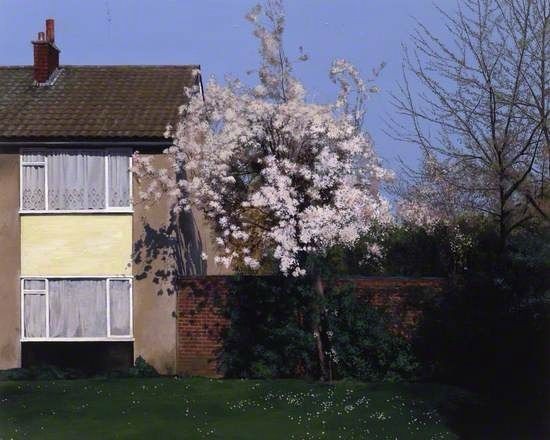
Coventry Society member, Peter Hunter, launches a campaign to hold a George Shaw exhibition in the city. Peter writes…….
I get goose pimples looking at the work of George Shaw depicting life in Coventry, of life in Tile Hill in particular. Many people locally will be familiar with Shaw’s ultra realistic work, but for the many who aren’t, take a look online at his images of life in Tile Hill in the first quarter of this century.
I didn’t grow up in the Tile Hill area, Bell Green was my home, next door to the Wood End and Manor House estates. However, the design, layout and architecture of Coventry’s post war council estates is so similar that images of one resonate with anyone familiar with the others.
Shaw’s work provides Coventry with a unique legacy, the images of a time and a place; nostalgia increasingly tinged with edginess. Shaw’s images are often mundane, every-day, but it’s this ultra realistic ordinariness that makes them so remarkable for me, recording life as it was for Shaw and transporting me back to my past.
George Shaw was born in Coventry in 1966 and went to school in the city. He originally got a BA in art at Sheffield Polytechnic in 1989 than in 1998 he got an MA at the Royal College of Arts. He was nominated for the Turner Prize in 2011.
His style is a unique, highly detailed, naturalistic approach using Humbrol enamel paints, paints that are traditionally associated with plastic model kits. His work is also devoid of people, it is about place and time. People would only distract.
Exhibitions across the UK, Europe and the US have taken place over many years although his last major exhibition in Coventry seems to be in 2011, a long time ago now, at the Herbert. The exhibition was entitled “George Shaw, I Woz Ere”.
There is an extensive body of Shaw’s work relating to Coventry which has increased significantly since the 2011 exhibition, with the more recent work less nostalgic and decidedly more edgy.
It would be good to see another exhibition of his work in the city sometime soon creating an awareness of this unique body of work amongst as wide a local audience as possible. Coventry should be immensely proud of the legacy which he has left; a legacy of a time and place recorded with real passion.
In an interview a few years ago, Shaw was asked if he thought his work could be placed in a tradition of English painting. His answer was “Oh, I hope so, yes. And not only painting, but English cultural life, really. I’d like to be identified as being part and parcel of the history of English culture – that would be nice.” For me as a Coventry kid, that is where I see George Shaw, recording the culture of my city, in my time in a totally unique way.
I do find it odd that Shaw’s work and name isn’t more widely recognised in his home City. We make much of our popular musical heritage and musicians, but in George Shaw we have a visual artist, a painter of national significance who has exhibited internationally – taking Tile Hill to the world – but for most people in Coventry, the name means little.
Shaw and his work deserve wider local recognition and I for one would appreciate another major local exhibition of his work. It is 14 years now since he last exhibited on a significant scale in Coventry.
George Shaw now lives in Devon and gradually but surely, I’m sure the focus of his work will shift in this direction as his ties to Coventry become looser. The council house in which he was brought up and which features in his work is now someone else’s home. Many of the places associated with his childhood and youth have gone, however Coventry should be immensely proud of the legacy which he has left; a legacy of a time and place and a record of a culture captured with a passion.

